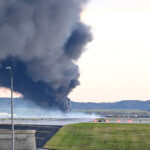Property casualty insurers increasingly steered clear of the water out of fear of catastrophe losses during the past year. But while they were keeping a wary eye on the coasts in 2006, and escaped relatively unscathed in those areas thanks to a mild hurricane season, the industry racked up its biggest catastrophe losses in states away from the oceans.
For 2006, the states where insurers reported the largest catastrophe losses included Indiana, Missouri, Tennessee and Kansas. Texas also made the top five in catastrophe losses.
The industry’s Insurance Services Office’s Property Claim Services (PCS) unit identified 33 catastrophe events in 2006. Together these events cost insurers an estimated $8.8 billion.
The 33 events caused insured property damage in 34 of the 50 states and the District of Columbia. Following are the states with the largest losses:
Indiana $1.5 billion
Missouri $878 million
Tennessee $873 million
Texas $688 million
Kansas $601 million
The catastrophe losses in these five states represent half of the total catastrophe losses in the United States for the year, according to PCS.
Losses from catastrophe events declined sharply in 2006 but were nonetheless at their sixth highest level since 1997. The frequency of catastrophe events rose last year to its second highest level in a decade. The following table displays annual insured property damage from catastrophe events and their frequency for the past ten years.
PCS estimates that insurers received 2,272,000 claims for damage to personal and commercial properties and vehicles. Personal lines claims accounted for 58 percent of the total, while commercial lines claims were at 9 percent and vehicle claims at 33 percent.
The 2006 hurricane season produced only one storm of catastrophe proportions, Tropical Storm Ernesto, which caused close to $250 million in insured property damage.
The National Hurricane Center recently reported that a tropical system that formed in July was not appropriately named as a tropical storm. The storm formed on July 17 approximately 210 nautical miles southeast of Nantucket, Massachusetts. It reached tropical storm strength with winds of 45 miles per hour later that day. It became extra-tropical the next day.
With this storm added to the count, the 2006 season included 10 storms. Five of them were hurricanes, with two reaching major hurricane status. These numbers reflect the long-term average for tropical systems.
Third-Quarter Update
PCS originally reported that the estimate for insured property damage related to seven catastrophes in the third quarter tallied $971 million, at the time the third lowest amount for the period in the last ten years. However, PCS employs a resurvey process through which it measures any development of insured damage over time. As a result, the estimate for insured damage during the quarter has risen to a total of $1.251 billion due to an influx of claims.
Even with this updated information, the quarter still ranks as the third lowest in the last decade, following far behind the especially costly hurricane seasons of 2004 and 2005 and the terror attack of 2001.
Fourth-Quarter Update
The year 2006 ended with six catastrophes identified by PCS in the last quarter. The frequency of events in this quarter tied the six events in 2002 as the most in any fourth quarter since 1998. The estimated insured property damage in this quarter ranks fourth highest since 1998 at $1.19 billion.
Three of the six events resulted from severe weather, including wind, hail, tornadoes and flooding. Two of the events were classified by PCS as winter storms, since the perils included freezing, snow and ice.
PCS also broke into new territory in the fourth quarter when it assigned a separate serial number for workers compensation claims that can be filed by rescue and recovery workers who toiled at the site of the World Trade Center in 2001.
ISO’s PCS unit defines a catastrophe as an event that causes $25 million or more in insured property losses and affects a significant number of policyholders and insurers.
Source: Insurance Services Office
www.iso.com.
Was this article valuable?
Here are more articles you may enjoy.

 Boeing 2011 Warning May Offer Clues into 2025 UPS Jet Crash
Boeing 2011 Warning May Offer Clues into 2025 UPS Jet Crash  Tesla, EEOC Plan Talks to Settle Factory Racism Suit
Tesla, EEOC Plan Talks to Settle Factory Racism Suit  Musk’s xAI Faces California AG Probe Over Grok Sexual Images
Musk’s xAI Faces California AG Probe Over Grok Sexual Images  Munich Re: Insured Losses From Wildfires, Storms and Floods Hit Record High
Munich Re: Insured Losses From Wildfires, Storms and Floods Hit Record High 